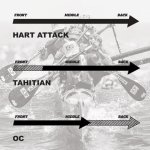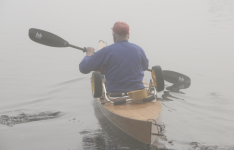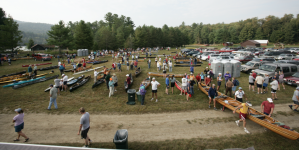-
Happy International Tea Day! 🫖🍵
You are using an out of date browser. It may not display this or other websites correctly.
You should upgrade or use an alternative browser.
You should upgrade or use an alternative browser.
Canoe Racing Pictures
- Thread starter Glenn MacGrady
- Start date
It is. My paddling partner Steve Conlon is good friends with him. Steve is the one that sent all those pics. Really good guy, love paddling with him.Clint: Is that Gareth Stevens in the last picture?
Alan
I raced against him a few times (always unsuccessfully) here in Iowa. Really great guy (as is almost everyone I met in the sport). He made it a special point to help me out when I was getting into racing and alway made me feel welcome.
Alan
Alan
If you want to go as fast as possible for long distances, you have to forget pig boats like marathon canoes and get yourself a canoe with a 10" waterline beam, such as mine.

The outrigger is the canoe that colonized the entire Pacific Ocean. Outrigger canoes are open canoes and are raced OC-1, OC-2 and OC-6. The top racers seem to have standardized on a 10° paddle bend and most prefer double bend shafts for shorter races and sprints. The Tahitians are the most efficient and fastest paddlers because of their blade catch technique and minimal air return times.

Here are OC-1's surfing. If you know how to "connect bumps", you can spend a lot of time not paddling and just sleighing downhill. Watch how Kai Bartlett can "fly the ama" while surfing big bumps. You can do this on big, windy lakes for outstanding fun.
Here is a very short video of an OC-6 race, which are wildly popular where there's always endless summer:

The outrigger is the canoe that colonized the entire Pacific Ocean. Outrigger canoes are open canoes and are raced OC-1, OC-2 and OC-6. The top racers seem to have standardized on a 10° paddle bend and most prefer double bend shafts for shorter races and sprints. The Tahitians are the most efficient and fastest paddlers because of their blade catch technique and minimal air return times.

Here are OC-1's surfing. If you know how to "connect bumps", you can spend a lot of time not paddling and just sleighing downhill. Watch how Kai Bartlett can "fly the ama" while surfing big bumps. You can do this on big, windy lakes for outstanding fun.
Here is a very short video of an OC-6 race, which are wildly popular where there's always endless summer:
It is awesome how they "ride the bump" and how they link them up from one to the next.If you want to go as fast as possible for long distances, you have to forget pig boats like marathon canoes and get yourself a canoe with a 10" waterline beam, such as mine.
Tell us more with your experience with the OC-1 Glenn.
To go along with the OC-1 is the V-1 correct?

I believe they are a flat water OC-1. I do not know much about the ama world of canoes. But have always wanted to paddle one. There is a fun little podcast I listen to out of California called Cocktails and Canoes with Kelly and Will. They talk about ocean racing and for me is a lot of to listen an learn about.
Just not sure how I could navigate on of these down a twisty river with logs in it.
Neat stuff. Just came across this one, where they swap fresh paddlers in an OC-6! About 9 and 17 minutes in.
To go along with the OC-1 is the V-1 correct?
Just not sure how I could navigate on of these down a twisty river with logs in it.
What they are now calling a V-1 is an outrigger canoe designed for the flatter waters of Tahitian lagoons, as opposed to the big ocean swells of the Hawaiian islands.
The differences between an outrigger V-1 and OC-1 are that the V-1 has no rudder, has a more sit-in enclosed cockpit, which can retain more water than the more sit-on-top OC-1 with Venturi footwells, and is longer with less rocker. The V-1 is a faster flatwater canoe because a rudder can increase drag by as much as 7%, but is not as good a wave surfer. Without a rudder, the V-1 requires more single blade correction skills like a CanAm open canoe.
I've never paddled open ocean waves. I bought my OC-1 (which confusingly contains the model name V1-B) for use on inland waters, though I have paddled around Sanibel Island in Florida and in Cobscook Bay (Bay of Fundy territory) in Maine. The narrow beam, long length and rudder make the outrigger a great canoe to paddle upstream in sufficiently wide rivers and Florida spring runs. You couldn't run it down a very narrow, twisty creek of course.
I have taken the rudder off, which takes 20 seconds, to run beaver dam streams off Georgian Bay in Canada. My canoe has so much rocker that it can be turned relatively well for 22', and it can just slide right up a beaver dam. When you are on top of the dam, you don't have to "get out" of the canoe; you just stand up, easily straddling the 14" beam-at-rail hull.
My canoe was not built for racing lightness, as I had an extra layer of fiberglass put on the bottom of the carbon/Kevlar hull. It weighs about 30 pounds and is easily carried on the shoulder for portages, which I have done in the BWCA and Adirondacks.
Unfortunately, most of my outrigger photos as I drove it all over the American west, Yellowstone, the BWCA, Algonquin, Georgian Bay, and the Adirondacks are on an old, dead computer, and I don't know how to get them off.
Here I am on the Lewis River in Yellowstone in 2004. The park rangers who took the photos said I was the first outrigger canoeist ever seen in Yellowstone.


Glenn, A good computer repair shop can remove the hard drive and extract your info (unless it’s damaged).
A buddy had a similar problem on an old computer he used to do the original map development work for the Wabakimi Project map booklets. He removed the hard drive and the manufacturer of the drive was able to recover all the data for him and the Project. My recall is that it cost something in the range of $17-1900.00. Costly but worth it - the Project board reimbursed him.Glenn, A good computer repair shop can remove the hard drive and extract your info (unless it’s damaged).
Adirondack 90 Mile Canoe Classic
We are often fog bound at the day1 start in Old Forge NY. But it usually means a sunny day ahead.




Gooooooooo!
Brian ("Mac"), the race director, sets off each "wave" of boats on their way.

Kerry, 30+ year 90-miler veteran, Long known as "Straw Hat Guy", Six time Yukon Race paddler, guides his "Slenda Glenda" voyageur team on 4th Lake.

Lifelong family friends take their place on 4th lake.

Navigating the end of hundreds of sharp turns in swampy Brown's Tract. (My favorite segment of the "90")

Finishing Brown's There's always a beaver dam before entering Raquette lake.

My 80 year old friend wheeling his home made kayak on the carry of his last ever 90-miler

Day2, at Long Lake, find your boat.


Day2 Start

Bob accepts assistance entering Day3 at Fish Creek Ponds

Day3 Start

For many years a piper treated us to tunes at the summit of the Bartlett Road carry on Day3.


Crosssing the finish line on Day3 on Lake Flower at Saranac Lake

Brian at the awards table, Saranac Lake.

Another year, digging in in a C4 before turning under the bridge on Day3

We are often fog bound at the day1 start in Old Forge NY. But it usually means a sunny day ahead.




Gooooooooo!
Brian ("Mac"), the race director, sets off each "wave" of boats on their way.

Kerry, 30+ year 90-miler veteran, Long known as "Straw Hat Guy", Six time Yukon Race paddler, guides his "Slenda Glenda" voyageur team on 4th Lake.

Lifelong family friends take their place on 4th lake.

Navigating the end of hundreds of sharp turns in swampy Brown's Tract. (My favorite segment of the "90")

Finishing Brown's There's always a beaver dam before entering Raquette lake.

My 80 year old friend wheeling his home made kayak on the carry of his last ever 90-miler

Day2, at Long Lake, find your boat.


Day2 Start

Bob accepts assistance entering Day3 at Fish Creek Ponds

Day3 Start

For many years a piper treated us to tunes at the summit of the Bartlett Road carry on Day3.


Crosssing the finish line on Day3 on Lake Flower at Saranac Lake

Brian at the awards table, Saranac Lake.

Another year, digging in in a C4 before turning under the bridge on Day3

Attachments
For TCKRA today was our opening race for the season. The Spring Break Open. I did not get to go as it is 5 hours away. But here is a video of the start. Patty is our main social media person and does a lot of the videoing and picture taking. So she is trying to narrate, video and take pictures at the same time.

 fb.watch
fb.watch

2023 TCKRA Spring Break Open: 14 miles from Amigos Beach at the Fentress bridge to Luling 90. A great turn out of 35 boats! | By Texas Canoe and Kayak Racing Association | Facebook
55 views, 12 likes, 0 loves, 0 comments, 0 shares, Facebook Watch Videos from Texas Canoe and Kayak Racing Association: 2023 TCKRA Spring Break Open: 14 miles from Amigos Beach at the Fentress bridge...
 fb.watch
fb.watch
Very eclectic bunch of boats. 
Delete post
Last edited:
I went thru there this morning on my way up north, wanted to stop at the country store for a tea to go but the place was packed with canoes on roofs and people in funny looking clothes.
I got scared and kept on truckin'
I got scared and kept on truckin'
Got some nice cookies and brownies from that store. Paddlers need to replace carbs.
The first time I ran that race (~15 years ago) I was by myself with a solo canoe. When I got there I looked all around but didn't see a tent or desk to register. Finally I asked someone. It turns out the registration desk is set up in the basement of the church up on the hill, near the store. That's where it's always been.
The first time I ran that race (~15 years ago) I was by myself with a solo canoe. When I got there I looked all around but didn't see a tent or desk to register. Finally I asked someone. It turns out the registration desk is set up in the basement of the church up on the hill, near the store. That's where it's always been.
Similar threads
- Replies
- 0
- Views
- 508









